|
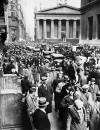 On October 29, 1929 the
American stock market dramatically crashed. Within the first few hours of
the Market's opening, it fell so far as to wipe out all the gains that had
been made in the previous year. Since the Stock Market was viewed as the
chief indicator of the health of the American economy, public confidence
was understandably shattered. Between October 29 and November 13 (when
stock prices hit their lowest point) over 30 billion dollars had
disappeared from the American economy. It was to take nearly twenty-five
years for many stocks to recover. On October 29, 1929 the
American stock market dramatically crashed. Within the first few hours of
the Market's opening, it fell so far as to wipe out all the gains that had
been made in the previous year. Since the Stock Market was viewed as the
chief indicator of the health of the American economy, public confidence
was understandably shattered. Between October 29 and November 13 (when
stock prices hit their lowest point) over 30 billion dollars had
disappeared from the American economy. It was to take nearly twenty-five
years for many stocks to recover.
Suddenly, far fewer families
could afford luxuries like electric Christmas lights. Food, clothing and shelter became the
priority, and Christmas celebrations were soon to become mere ghosts of
what they once were for many families.
Since the crash did not occur
until late in the year, the major lighting companies were already geared
up for a big selling season, and their offerings for 1929 were lavish.
Needless to say, there was a lot of leftover stock. Many sets first made
in that year were never offered again after the stock sold through. Other
sets were revised, soon to be made of less expensive materials.
Beginning in 1930, many of the
Christmas lighting companies started cutting costs wherever they could.
The wiring used in lighting outfits became thinner. Sockets were beginning
to be made of Bakelite, a much less expensive material than was
composition. Box art became less colorful and more utilitarian, to save on
printing and design costs. Package art from the previous era was also
"recycled", but this time printed in less dramatic colors. Novelty outfits
were introduced to entice the public to once again buy new lighting
strings. This was indeed a pivotal time for the American Christmas
lighting industry.
 |
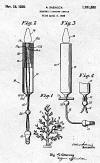 |
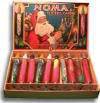 |
|
1929 NOMA candle set |
Patent for Candles |
Inside the Box |
|
This extremely rare NOMA candle
outfit is unusual for several reasons. First and most notable is the
exquisite box art, which NOMA used for only two years, 1928 and
1929. It is far more colorful than any other box ever put out by the
company. Secondly, these candles are individual rather than
permanently wired into a festoon, so that they could be placed
anywhere on the tree. The user just had to remove a lamp wherever he
or she wanted, and then replace it with a candle. The units are made
of swirl painted metal, with a short pigtail type cord with a
screw-in base at the bottom. A most unique item, and also one of the
few NOMA products to bear a 1928 copyright date. The patent for this
item, granted to Albert Sadacca, was not awarded until 1930, a year
after the set was discontinued. |
 |
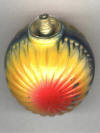 |
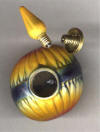 |
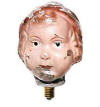 |
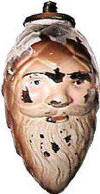 |
|
An Eight Light Set |
Sunburst Assembled |
Sunburst Apart |
Girl's Head |
Face in a Pine Cone |
|
A product of
NOMA, these very large figural lights are called Dresden Fancy
Lamps, and were an attempt to introduce a figural light with a
replaceable light source. The large painted glass envelopes were
imported from Germany, and the lamps were assembled in the United
States. They were first distributed in 1929. These units had several
distinct disadvantages that made them almost unusable. First, their
weight made it hard to decorate, as they would not remain upright.
Secondly, the parts that held the actual light socket were made of
dissimilar metals, causing them to corrode and fuse together, making
lamp replacement impossible after a year or two. A third
disadvantage was that the paint flaked off horribly, as shown in
these pictures. These issues, plus the fact that they were a high
priced product offered for sale at the height of the Depression, led
to their discontinuance in 1933.
UPDATE: Bruce Feddema, a friend and
fellow collector, has reported that he recently added a Pine Cone
Santa to his collection, similar to the one pictured above. The
major difference is that on his example, the metal components are
all made of brass. His parts were fused together as well, and when
Bruce applied a small amount of penetrating oil to begin to separate
the pieces, a clear liquid began to ooze out from where the pieces
were joined. Bruce is certain that this liquid is old lacquer, used
to keep the brass parts from tarnishing. He speculates that the heat
from the light bulb inside the Dresden light caused the lacquer to
melt, and as the light went through repeated cycles of heat and
cold, the lacquer eventually got so thick and heavy that it fused
the parts together.
It seems logical
to assume that the manufacturers of the metal parts realized that
the dissimilar metals they were using were causing problems, and at
some point switched to an all-brass construction. However, the
lacquer they used to keep the metal from tarnishing eventually
caused the same fusing problem they were trying to avoid! My thanks
to Bruce for this most interesting information. |
|
Date |
Manufacturer |
Notes |
Outside of Box |
Inside of Box |
| 1929 |
NOMA |
In 1929, NOMA
issued this box art for the first time, exclusively used to promote
their new outside light strings. The printing
quality for this particular box design was not very good, and it is
most often found with rather severely faded and/or misaligned
printing. For some reason, perhaps cheaper Depression era inks, the
box seems to be more susceptible to fading than most, resulting in
weak colors. This is a book style box, and the string contained
within uses the then new C-9 outdoor swirl lamps, with General
Electric's newly patented high quality inside coloring process,
insuring that the paint could not scratch off. |
 |
 |
| ca
1929 |
NOMA |
Here's another
example of a twinkling outfit, this one by NOMA. Circa 1929, the
twinkling device is practically identical to the Gacor set discussed
on the previous page, even down to the metal sockets. I believe it
is safe to assume that NOMA either purchased their twinkling devices
from Gacor, or by the time this set was made, NOMA had purchased the
Gacor company or patent rights. This NOMA box is very typical of the
other sets that were sold by the Company, with the only difference
being the word "Twinkler" added in small letters. This outfit sold
for $5.98, and like the Gacor outfit, was not a big seller. |
 |
 |
| ca
1929 |
Boehland & Company |
 Paul
Boehland and Company sold the unusual tree topper on the right,
called the Fairy Crown Christmas Tree Tip, beginning in 1929. It was
patented in 1928 and assigned number 1,690,397. When new, the
metal star had much more metallic glitter on it. Paul
Boehland and Company sold the unusual tree topper on the right,
called the Fairy Crown Christmas Tree Tip, beginning in 1929. It was
patented in 1928 and assigned number 1,690,397. When new, the
metal star had much more metallic glitter on it. |
 |
 |
| ca
1929 |
NOMA |
Metal Tree top
stars were first introduced in the early part of this decade by the
Propp Company. Consisting of a five pointed star and three candle
lights to make a string of 8 lights, the set was a popular seller.
NOMA offered this set first in 1929, after their merger with Propp.
|
 |
 |
| ca
1929 |
NOMA |
Starting in 1929,
NOMA also offered a "pigtail" version of the Star topper which is
pictured here, designed to screw into an existing string of lights
as a substitute for a single bulb. |
 |
 |
| ca
1929 |
Peerless |
 Offered
by Peerless, this is an unusual set containing intermediate base
round GE Mazda lamps. Originally sold as outside painted bulbs in
1927, the lights were not popular as Christmas lamps and by 1928 the
more appealing flame or swirled shaped bulbs had replaced them. In
an attempt to re-introduce the cheaper to manufacture round bulbs to
Christmas decorators, GE offered an improved version of the lamp
with inside coloring to last longer as in the outfit above. But,
just as before, people preferred the more traditional cone shaped
flame bulbs, and the rounds were no longer marketed as Christmas
lighting by 1930. Offered
by Peerless, this is an unusual set containing intermediate base
round GE Mazda lamps. Originally sold as outside painted bulbs in
1927, the lights were not popular as Christmas lamps and by 1928 the
more appealing flame or swirled shaped bulbs had replaced them. In
an attempt to re-introduce the cheaper to manufacture round bulbs to
Christmas decorators, GE offered an improved version of the lamp
with inside coloring to last longer as in the outfit above. But,
just as before, people preferred the more traditional cone shaped
flame bulbs, and the rounds were no longer marketed as Christmas
lighting by 1930. |
 |
 |
End of Chapter
HOME
TABLE OF CONTENTS
BACK
|
































